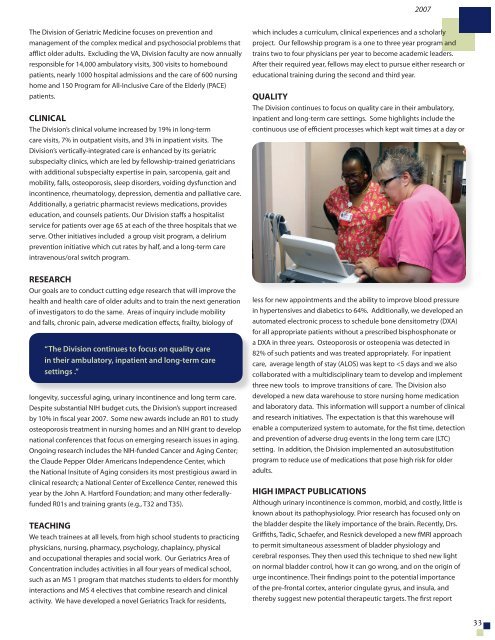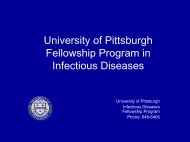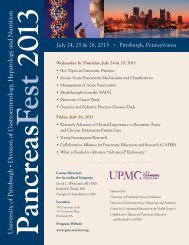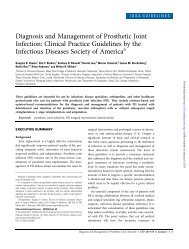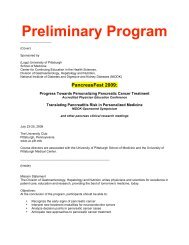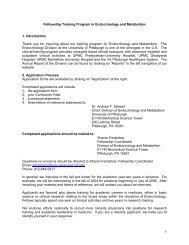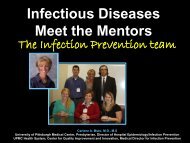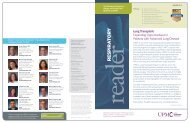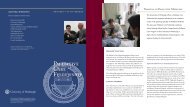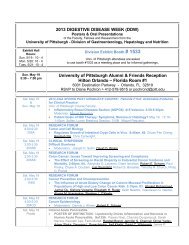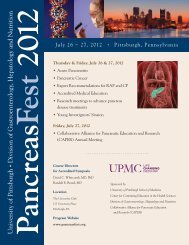2009 DOM Annual Report - Department of Medicine - University of ...
2009 DOM Annual Report - Department of Medicine - University of ...
2009 DOM Annual Report - Department of Medicine - University of ...
- No tags were found...
Create successful ePaper yourself
Turn your PDF publications into a flip-book with our unique Google optimized e-Paper software.
2007The Division <strong>of</strong> Geriatric <strong>Medicine</strong> focuses on prevention andmanagement <strong>of</strong> the complex medical and psychosocial problems thatafflict older adults. Excluding the VA, Division faculty are now annuallyresponsible for 14,000 ambulatory visits, 300 visits to homeboundpatients, nearly 1000 hospital admissions and the care <strong>of</strong> 600 nursinghome and 150 Program for All-Inclusive Care <strong>of</strong> the Elderly (PACE)patients.CLINICALThe Division’s clinical volume increased by 19% in long-termcare visits, 7% in outpatient visits, and 3% in inpatient visits. TheDivision’s vertically-integrated care is enhanced by its geriatricsubspecialty clinics, which are led by fellowship-trained geriatricianswith additional subspecialty expertise in pain, sarcopenia, gait andmobility, falls, osteoporosis, sleep disorders, voiding dysfunction andincontinence, rheumatology, depression, dementia and palliative care.Additionally, a geriatric pharmacist reviews medications, provideseducation, and counsels patients. Our Division staffs a hospitalistservice for patients over age 65 at each <strong>of</strong> the three hospitals that weserve. Other initiatives included a group visit program, a deliriumprevention initiative which cut rates by half, and a long-term careintravenous/oral switch program.which includes a curriculum, clinical experiences and a scholarlyproject. Our fellowship program is a one to three year program andtrains two to four physicians per year to become academic leaders.After their required year, fellows may elect to pursue either research oreducational training during the second and third year.QUALITYThe Division continues to focus on quality care in their ambulatory,inpatient and long-term care settings. Some highlights include thecontinuous use <strong>of</strong> efficient processes which kept wait times at a day orRESEARCHOur goals are to conduct cutting edge research that will improve thehealth and health care <strong>of</strong> older adults and to train the next generation<strong>of</strong> investigators to do the same. Areas <strong>of</strong> inquiry include mobilityand falls, chronic pain, adverse medication effects, frailty, biology <strong>of</strong>“The Division continues to focus on quality carein their ambulatory, inpatient and long-term caresettings .”longevity, successful aging, urinary incontinence and long term care.Despite substantial NIH budget cuts, the Division’s support increasedby 10% in fiscal year 2007. Some new awards include an R01 to studyosteoporosis treatment in nursing homes and an NIH grant to developnational conferences that focus on emerging research issues in aging.Ongoing research includes the NIH-funded Cancer and Aging Center;the Claude Pepper Older Americans Independence Center, whichthe National Insitute <strong>of</strong> Aging considers its most prestigious award inclinical research; a National Center <strong>of</strong> Excellence Center, renewed thisyear by the John A. Hartford Foundation; and many other federallyfundedR01s and training grants (e.g., T32 and T35).TEACHINGWe teach trainees at all levels, from high school students to practicingphysicians, nursing, pharmacy, psychology, chaplaincy, physicaland occupational therapies and social work. Our Geriatrics Area <strong>of</strong>Concentration includes activities in all four years <strong>of</strong> medical school,such as an MS 1 program that matches students to elders for monthlyinteractions and MS 4 electives that combine research and clinicalactivity. We have developed a novel Geriatrics Track for residents,less for new appointments and the ability to improve blood pressurein hypertensives and diabetics to 64%. Additionally, we developed anautomated electronic process to schedule bone densitometry (DXA)for all appropriate patients without a prescribed bisphosphonate ora DXA in three years. Osteoporosis or osteopenia was detected in82% <strong>of</strong> such patients and was treated appropriately. For inpatientcare, average length <strong>of</strong> stay (ALOS) was kept to


